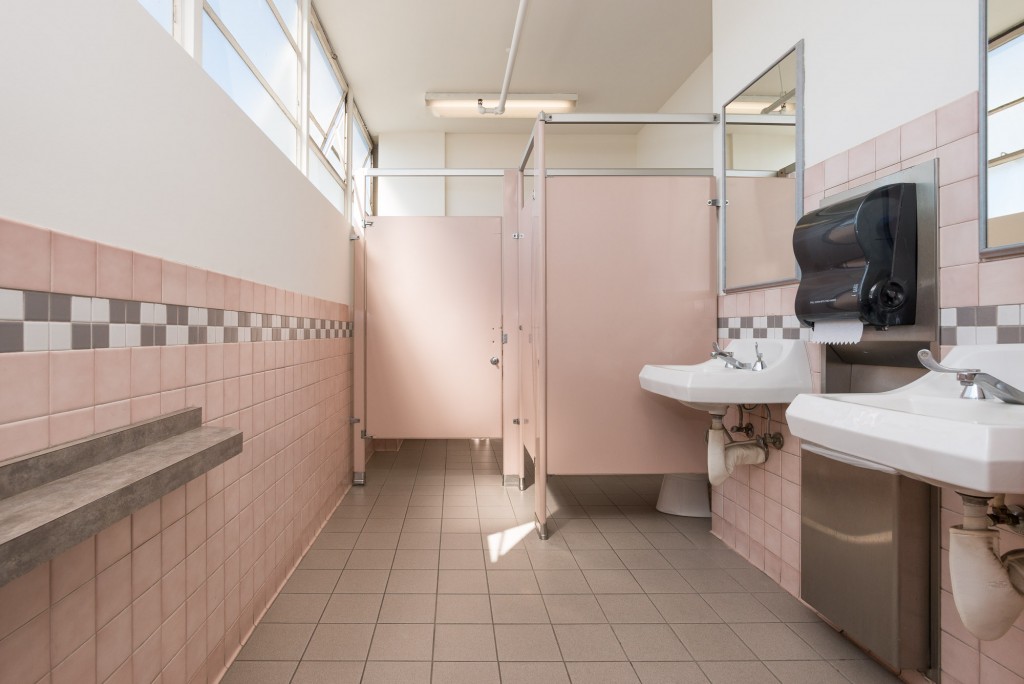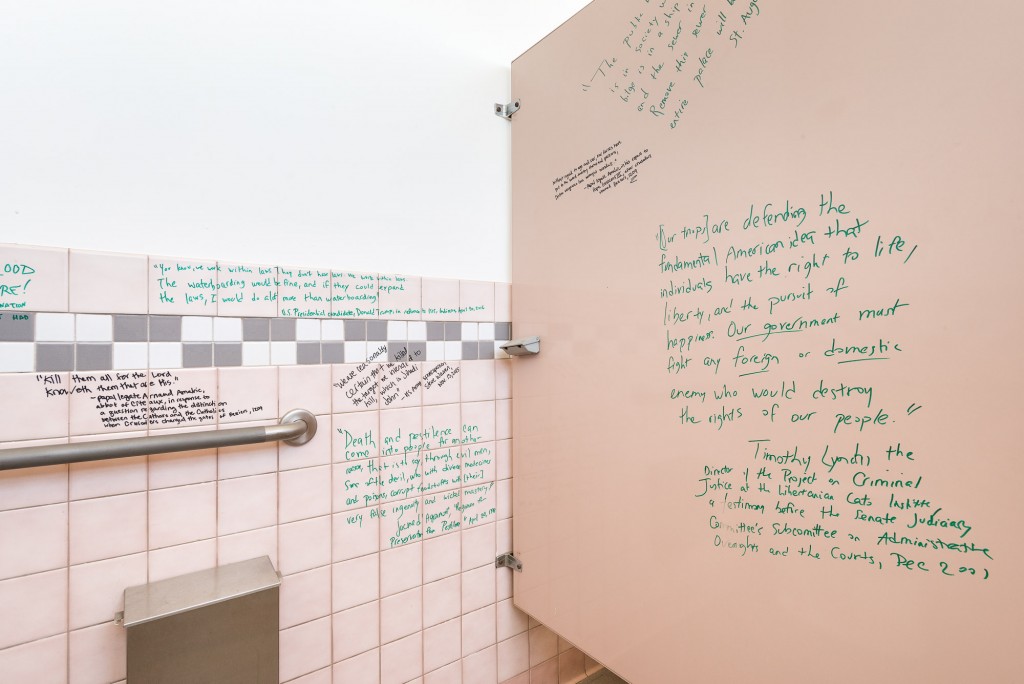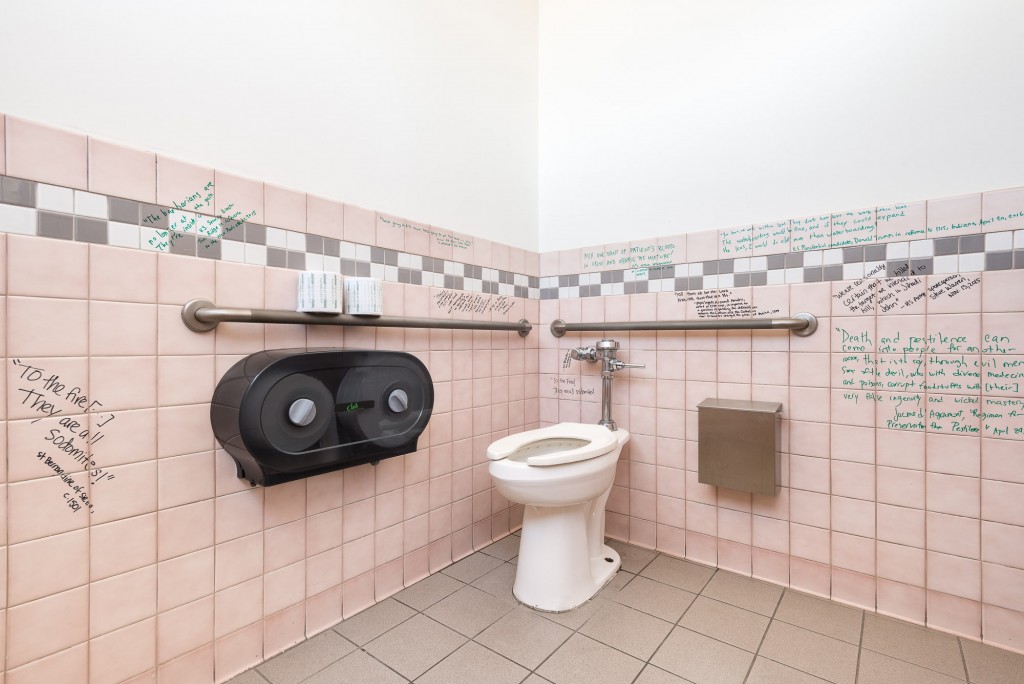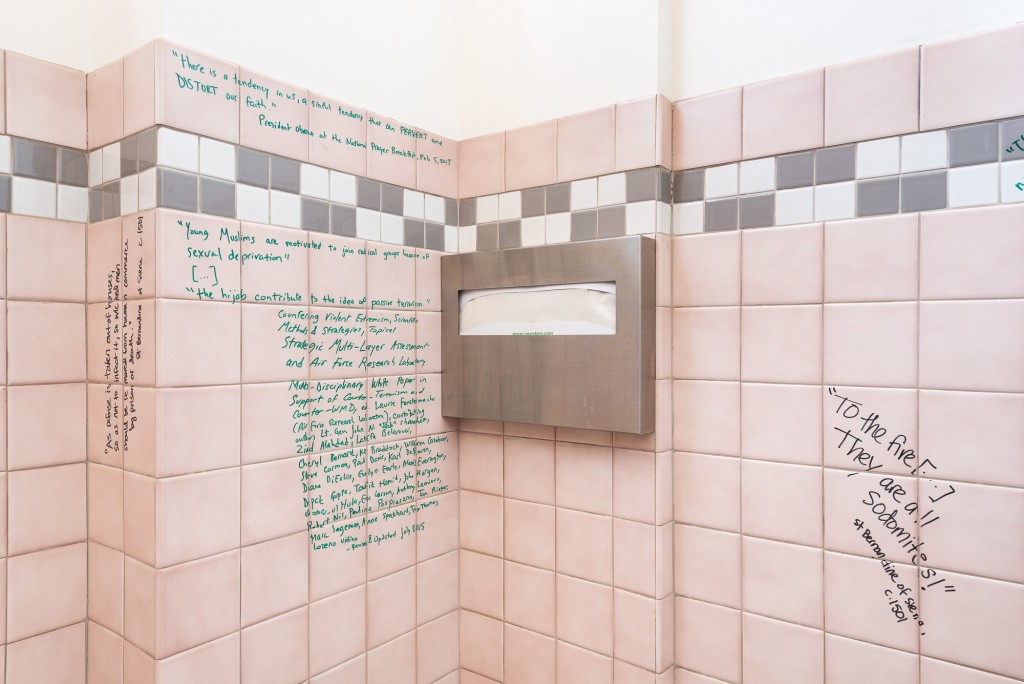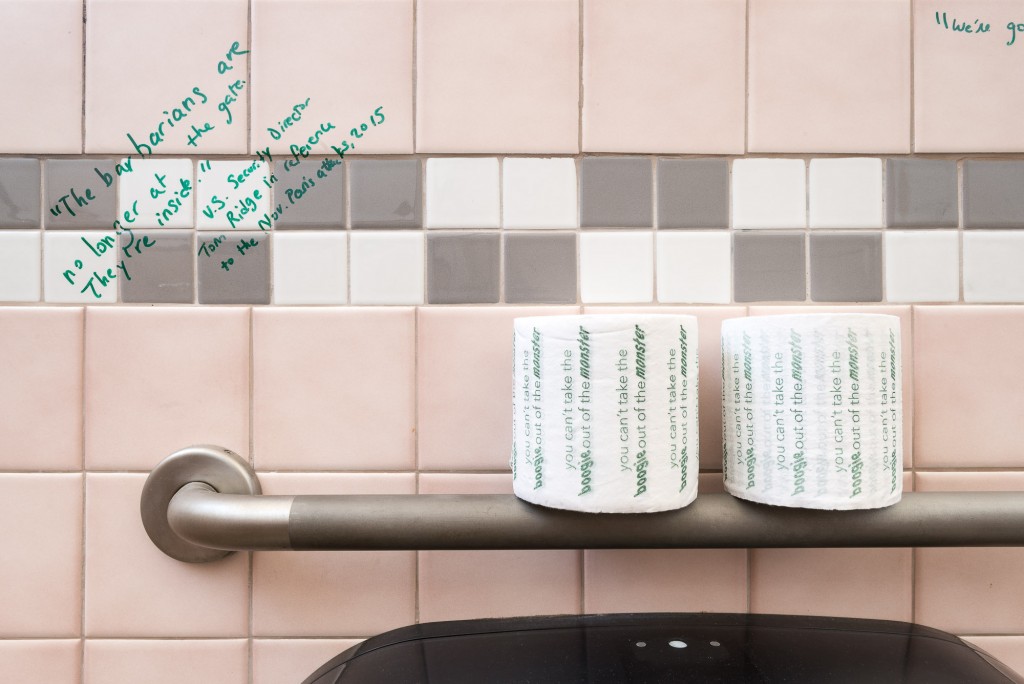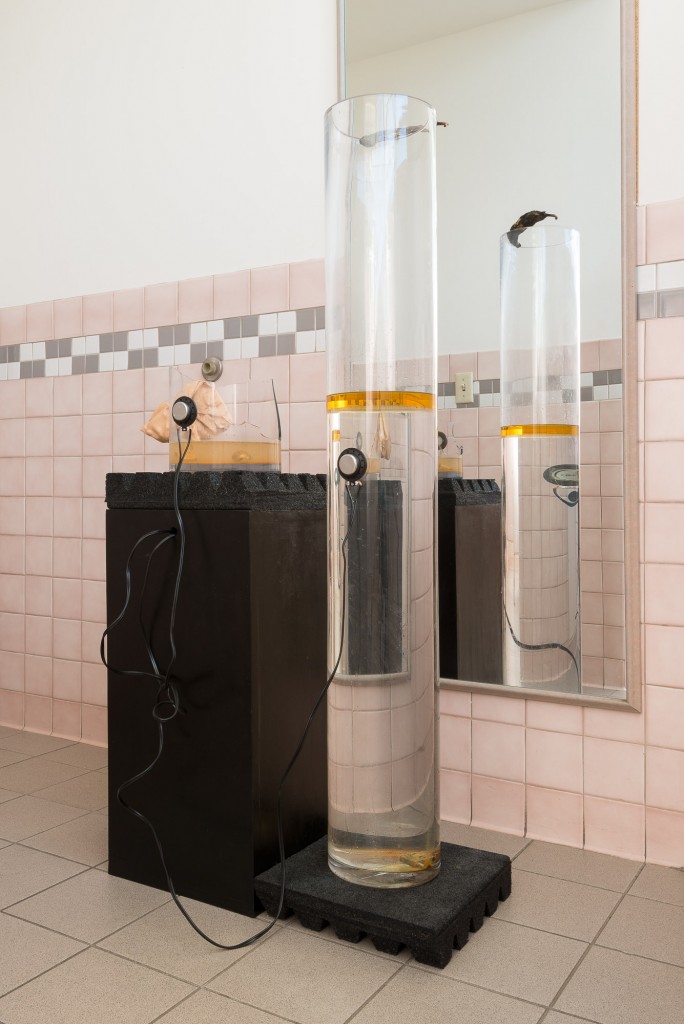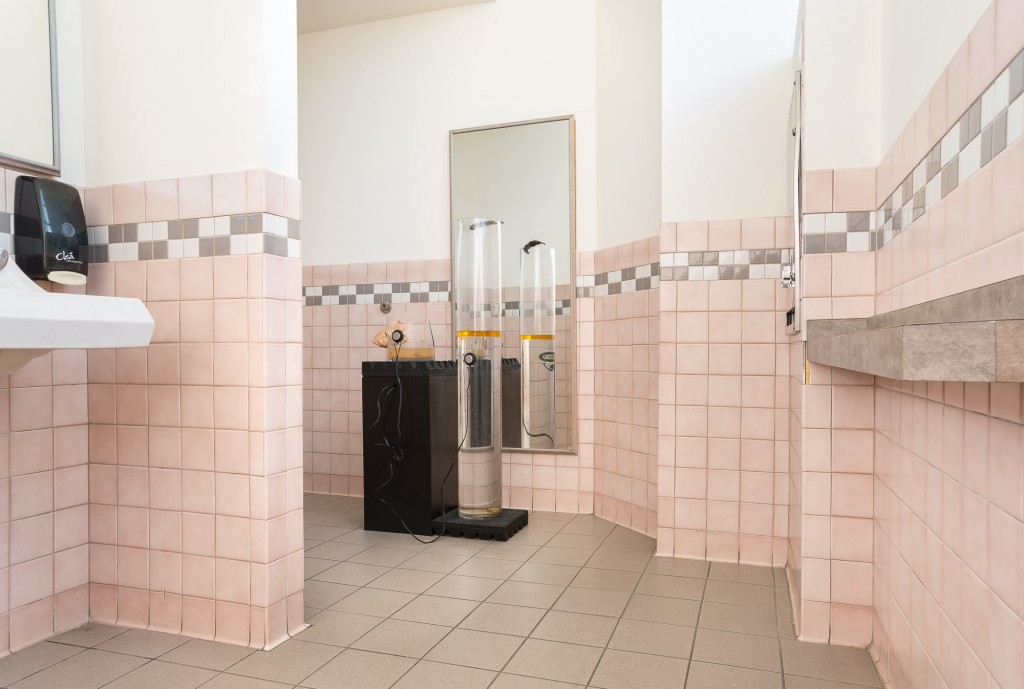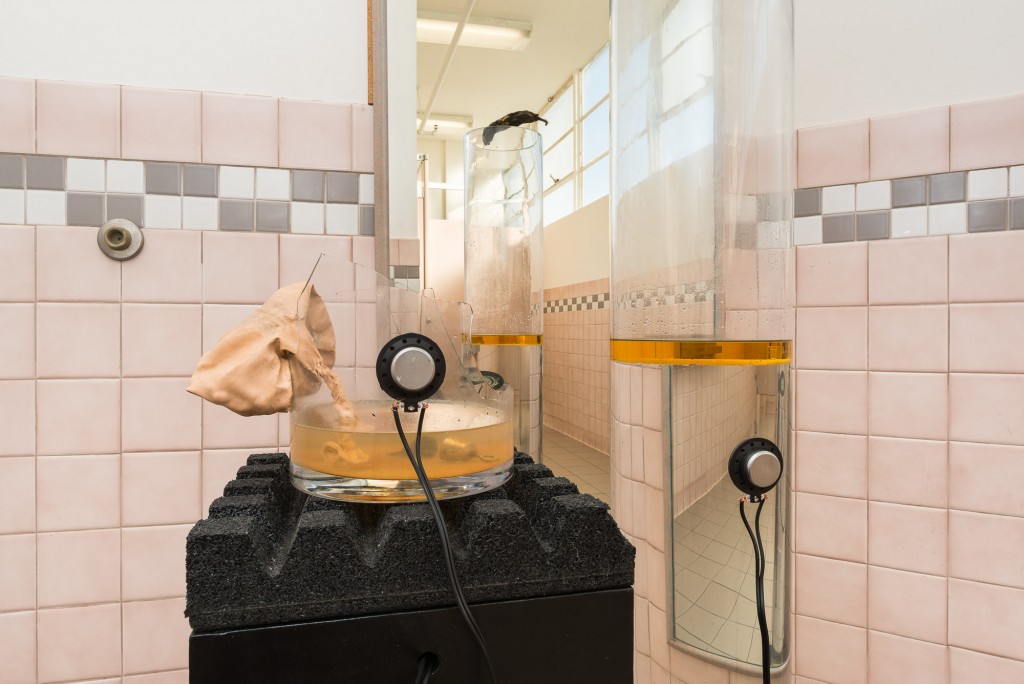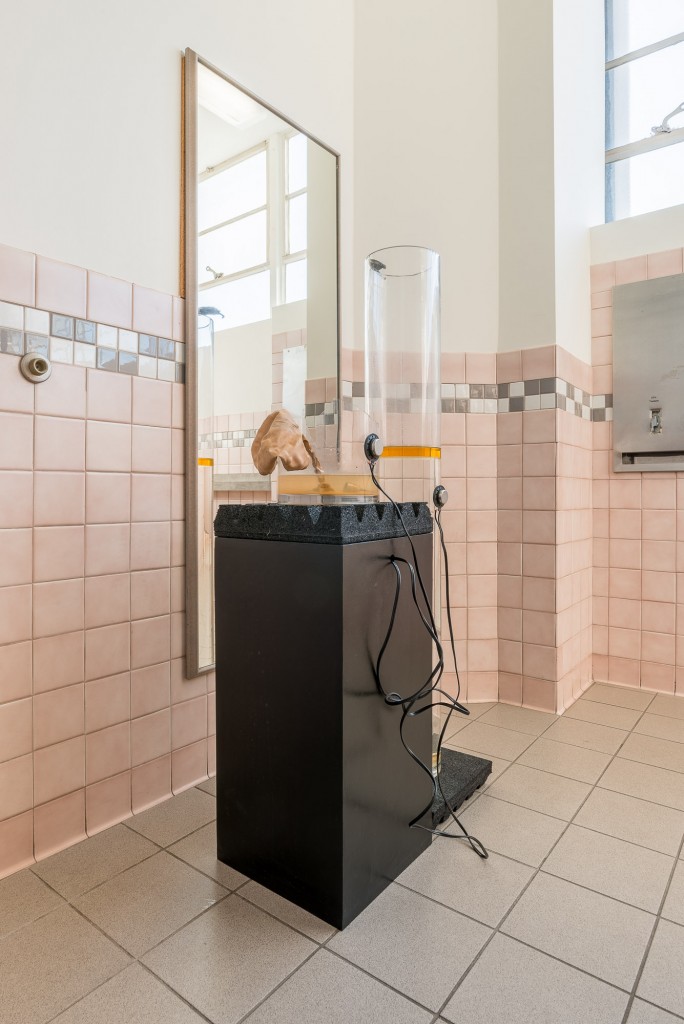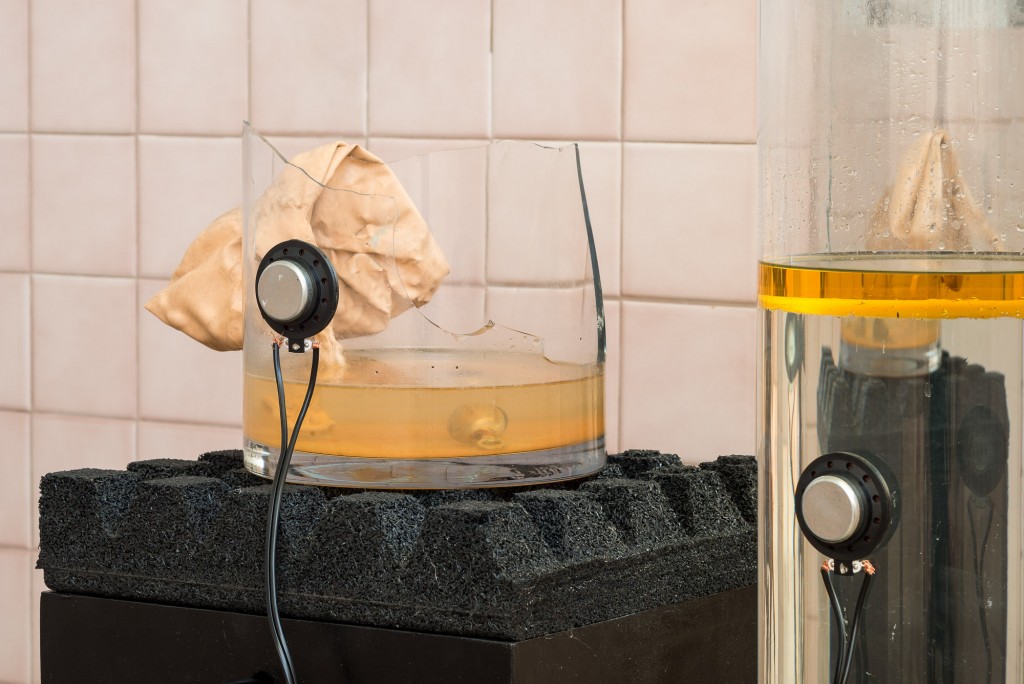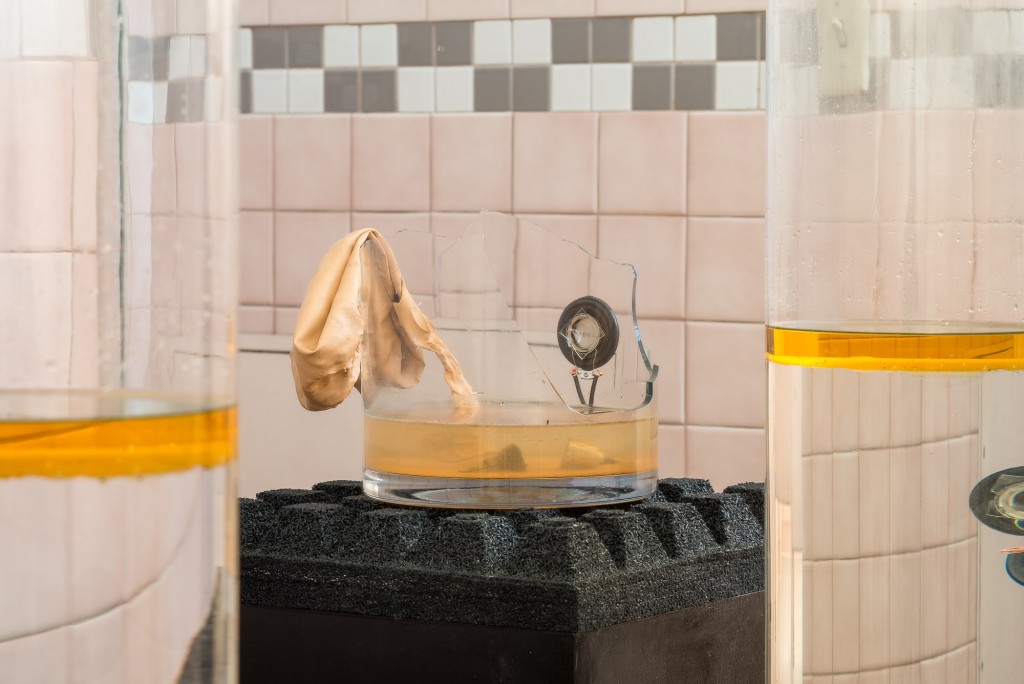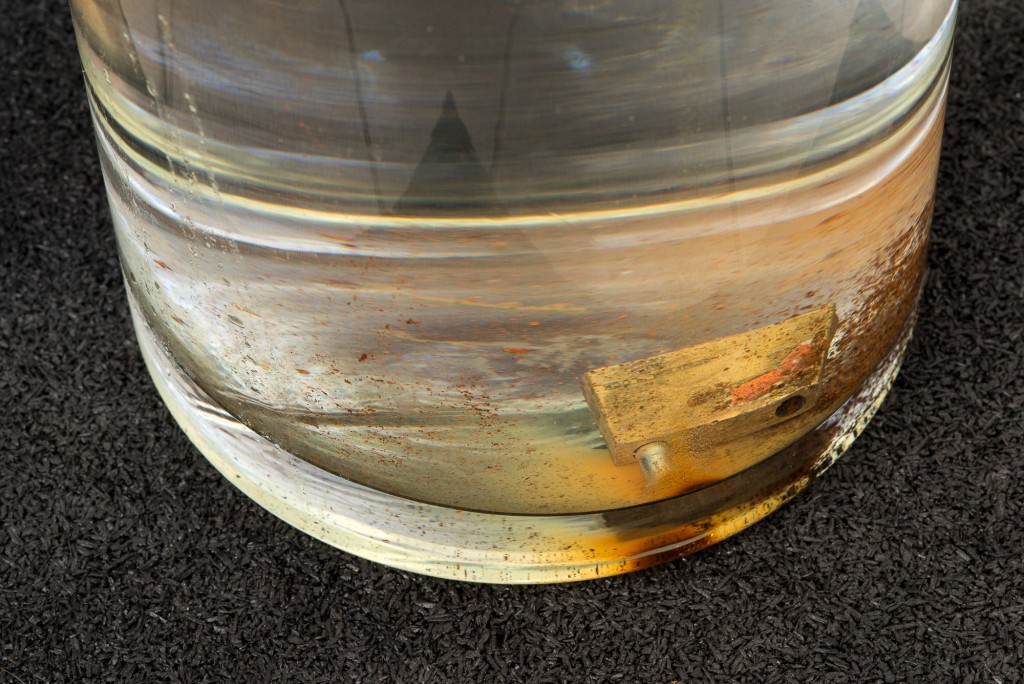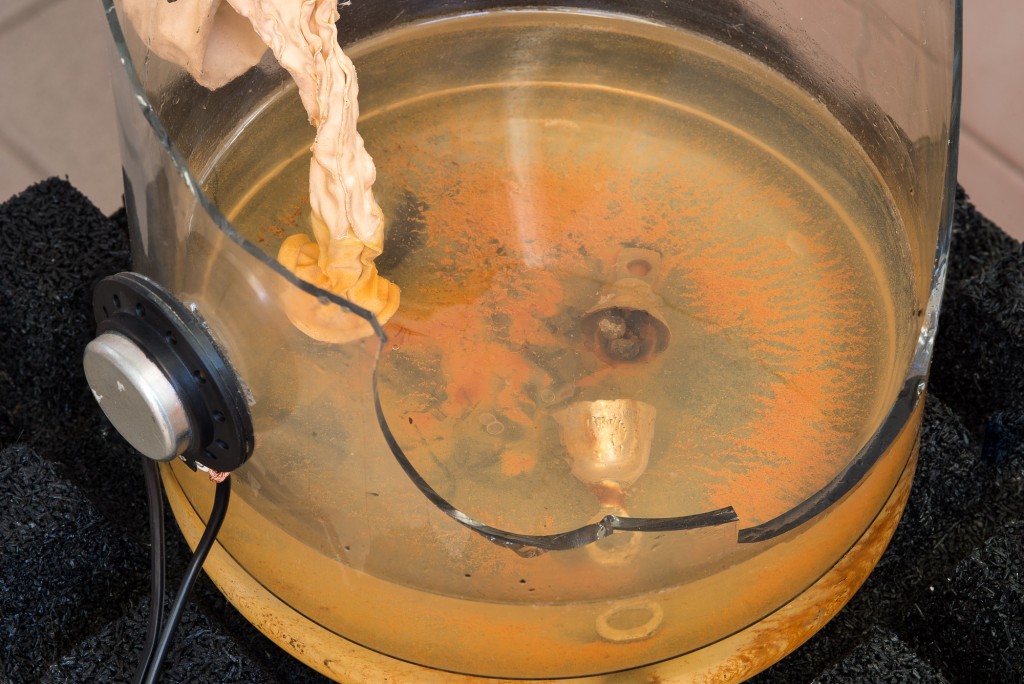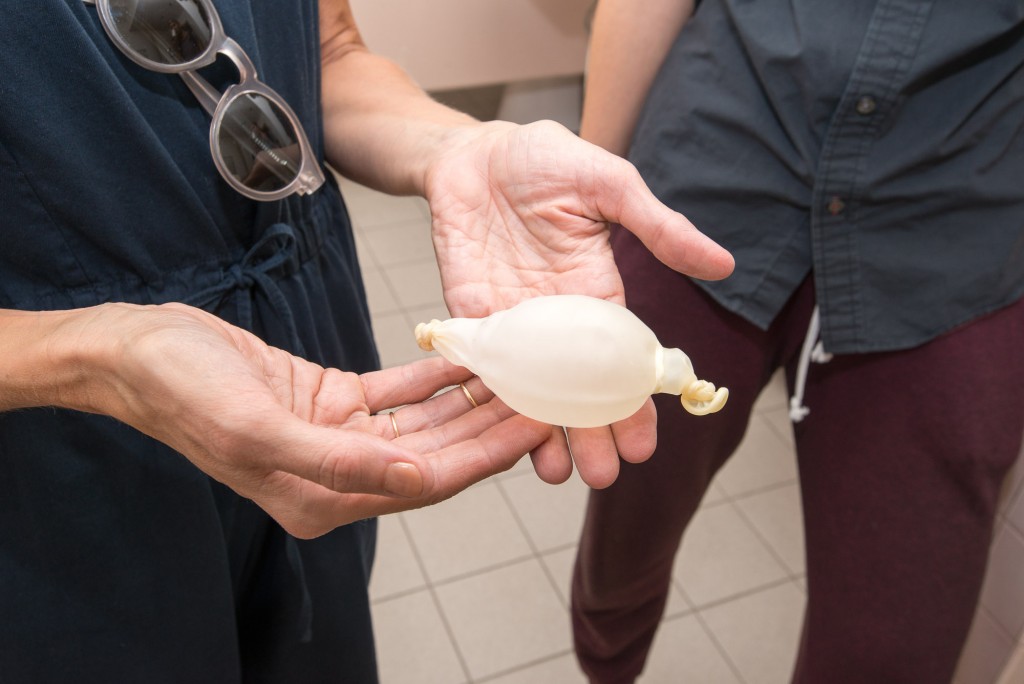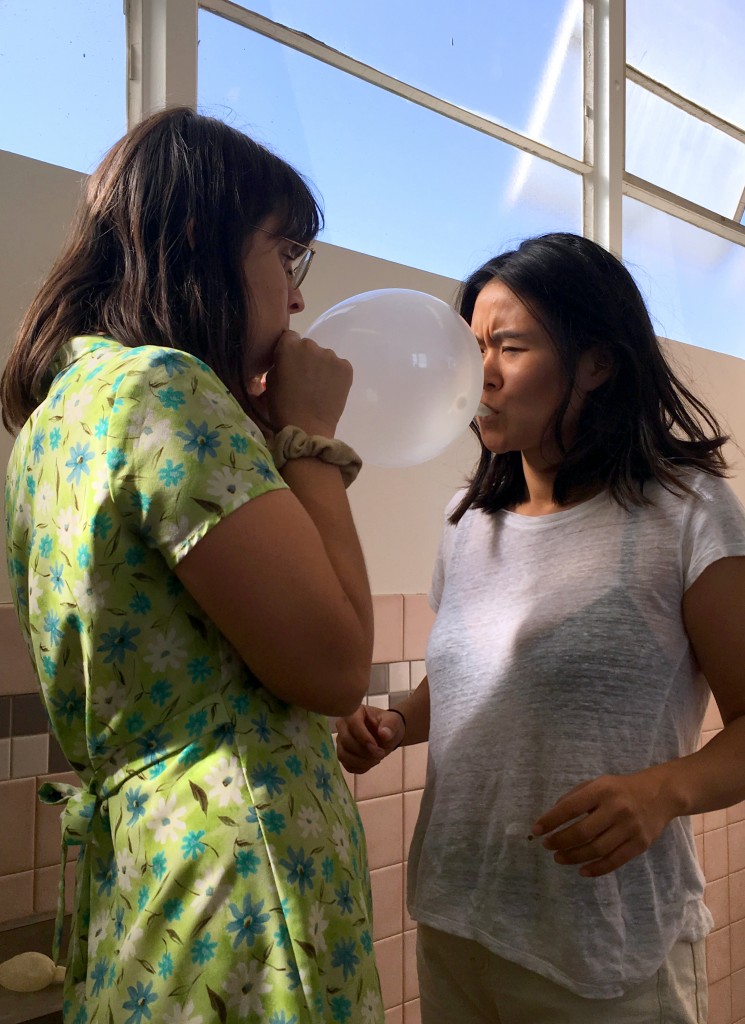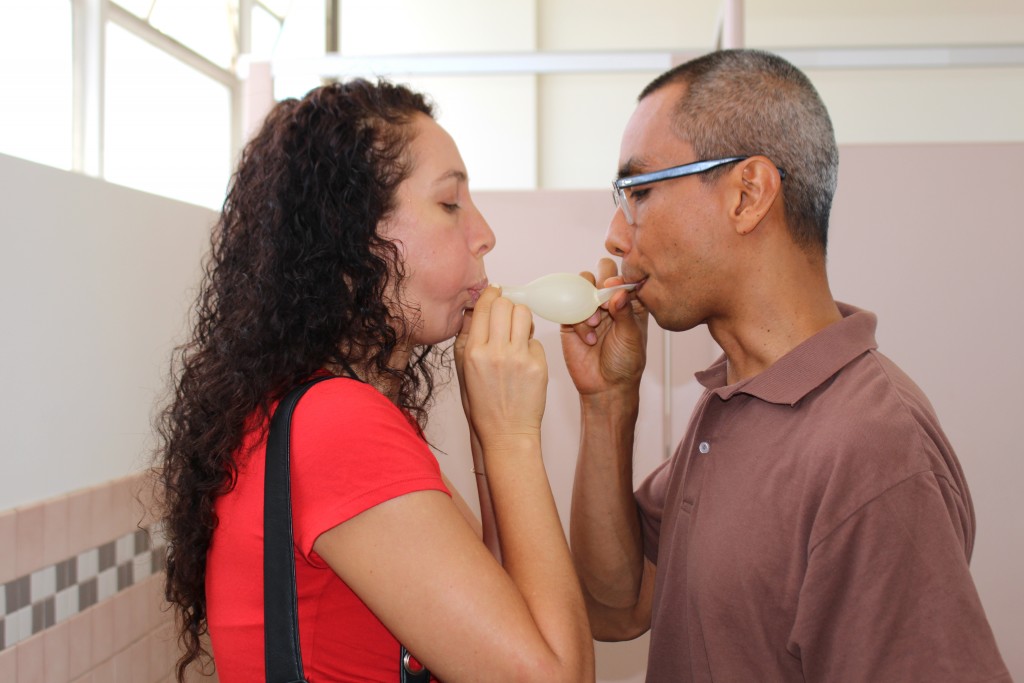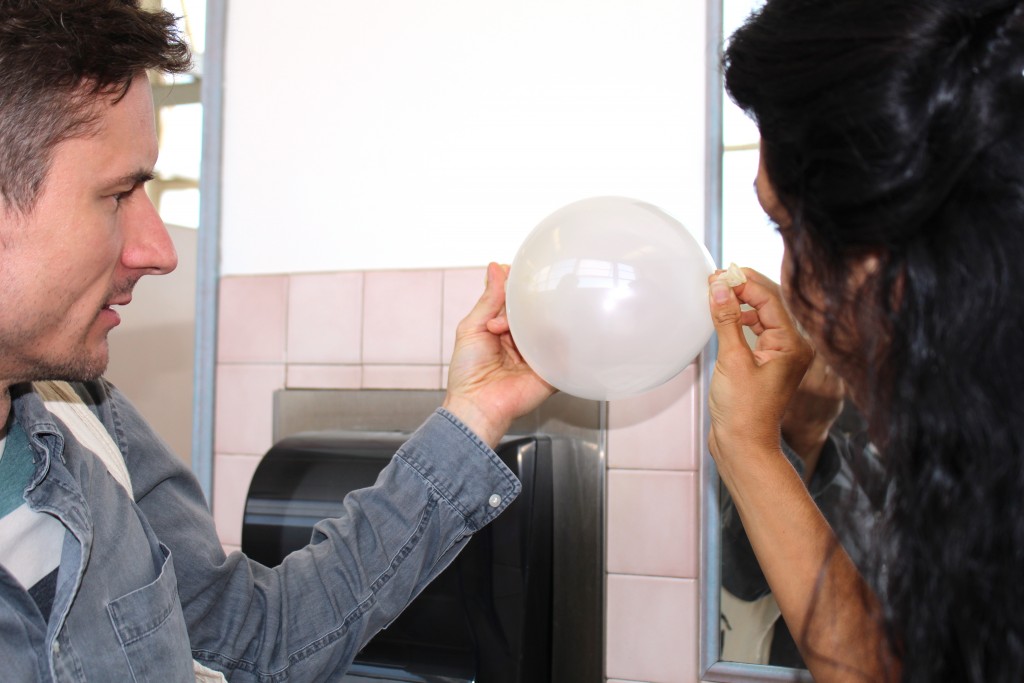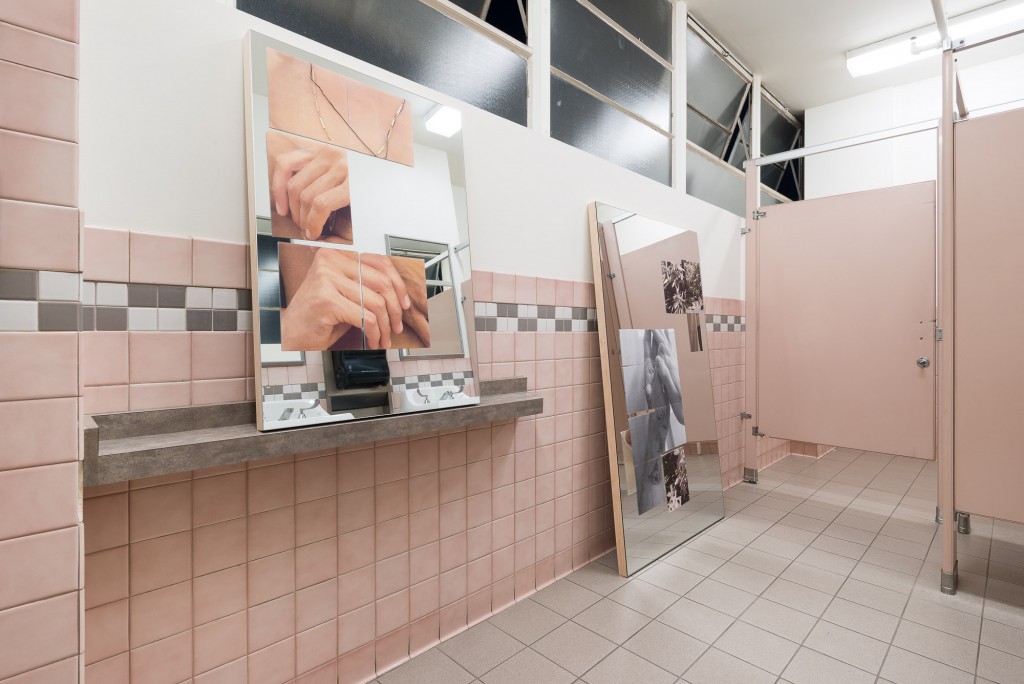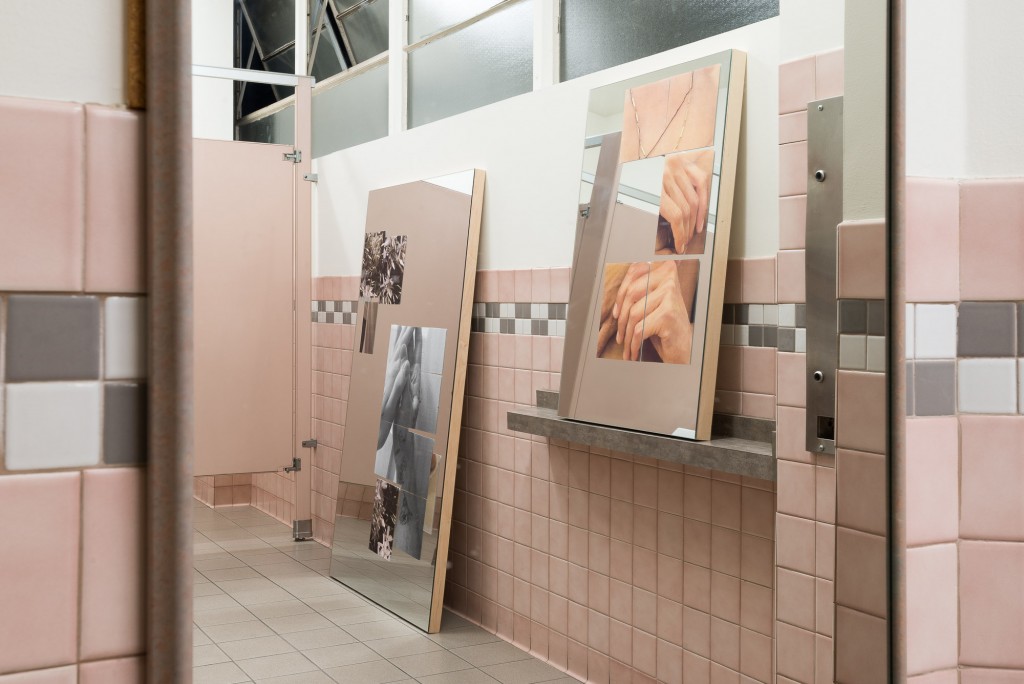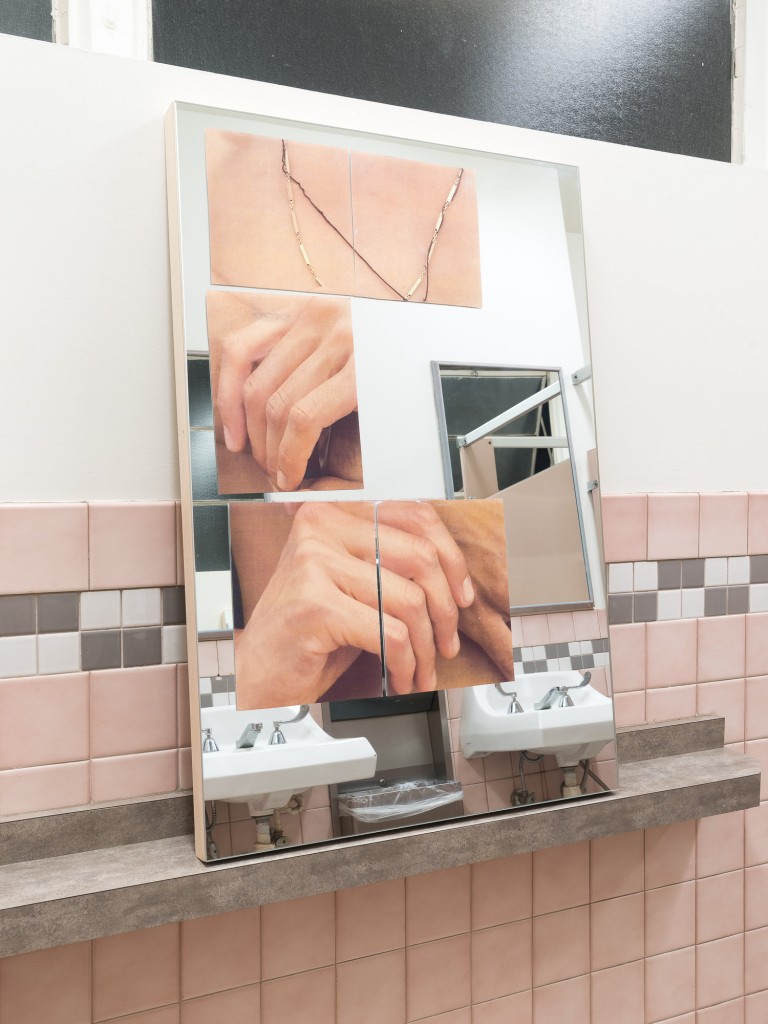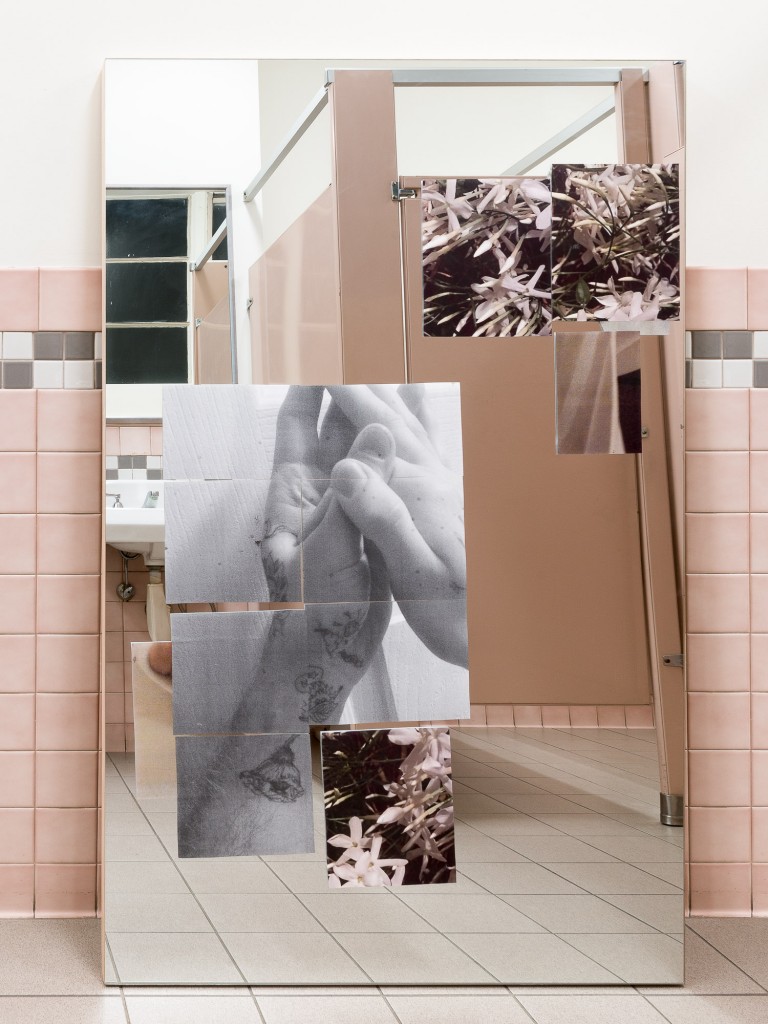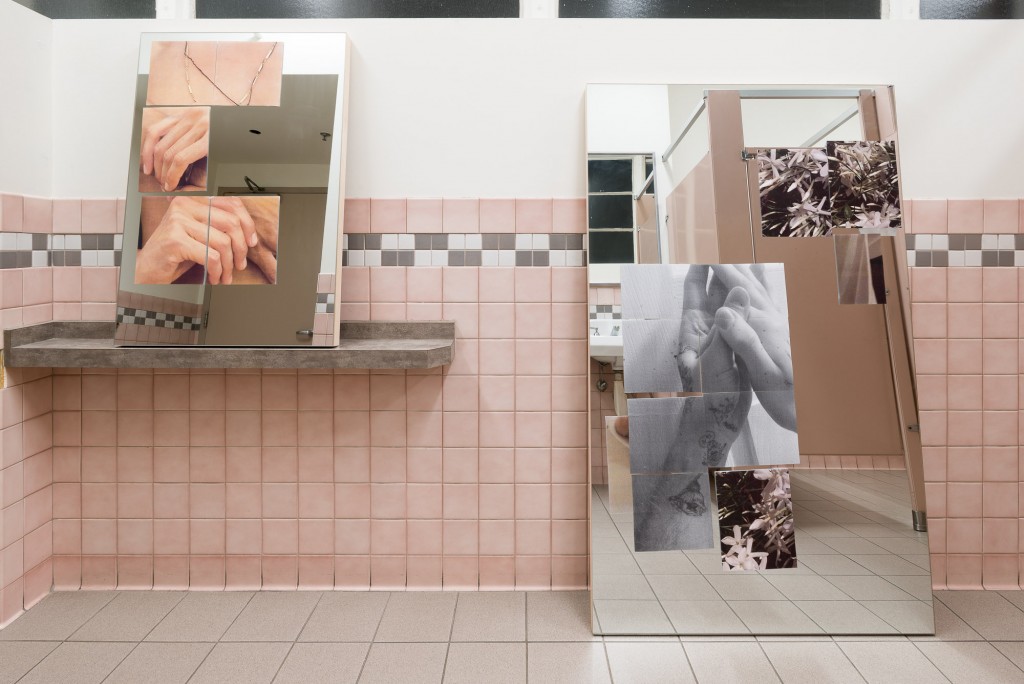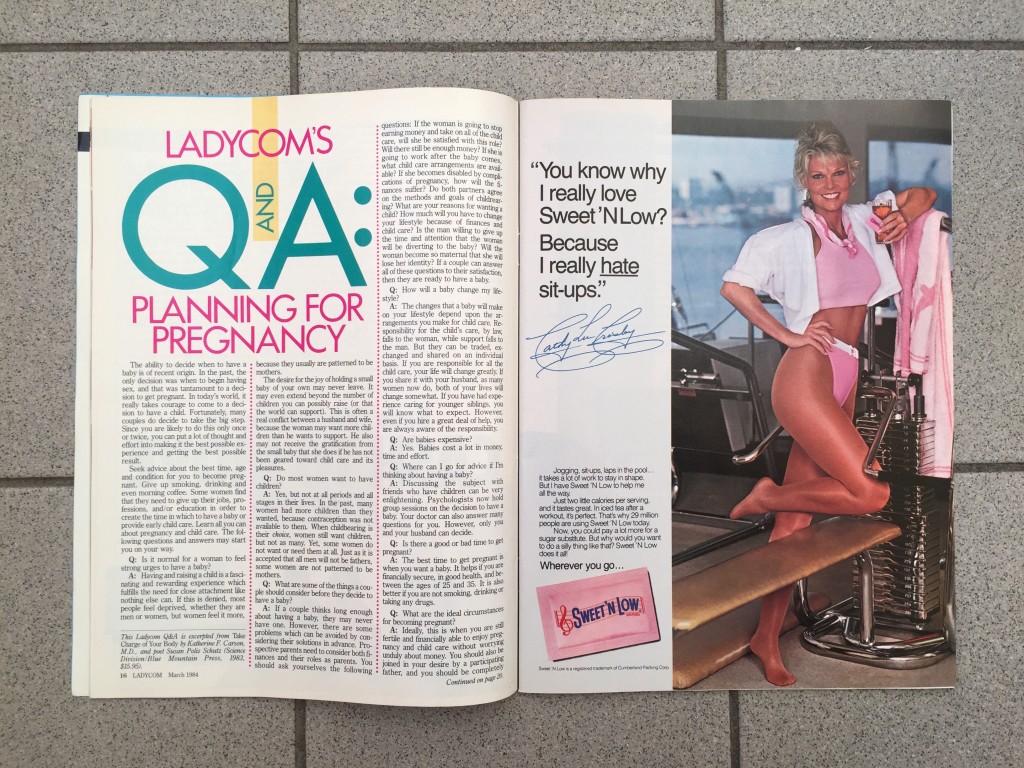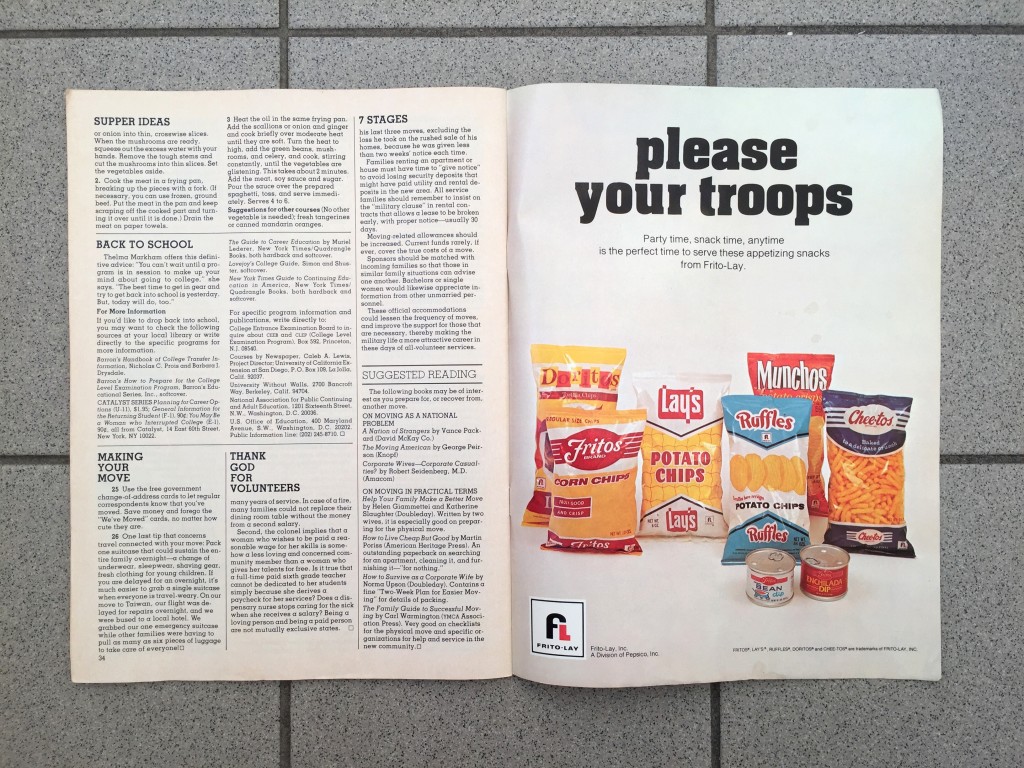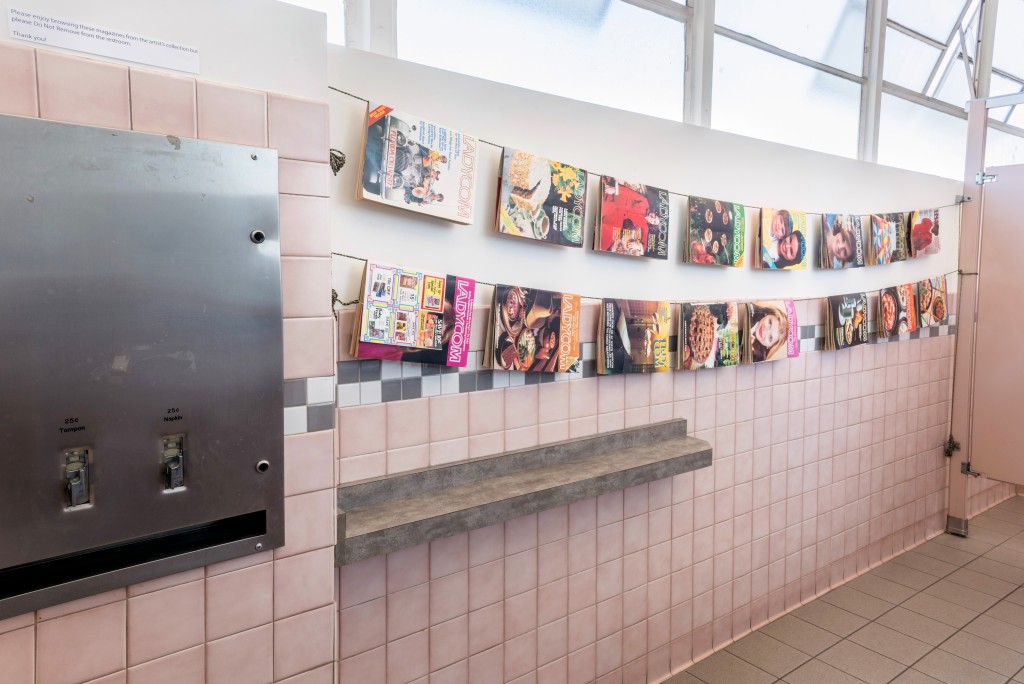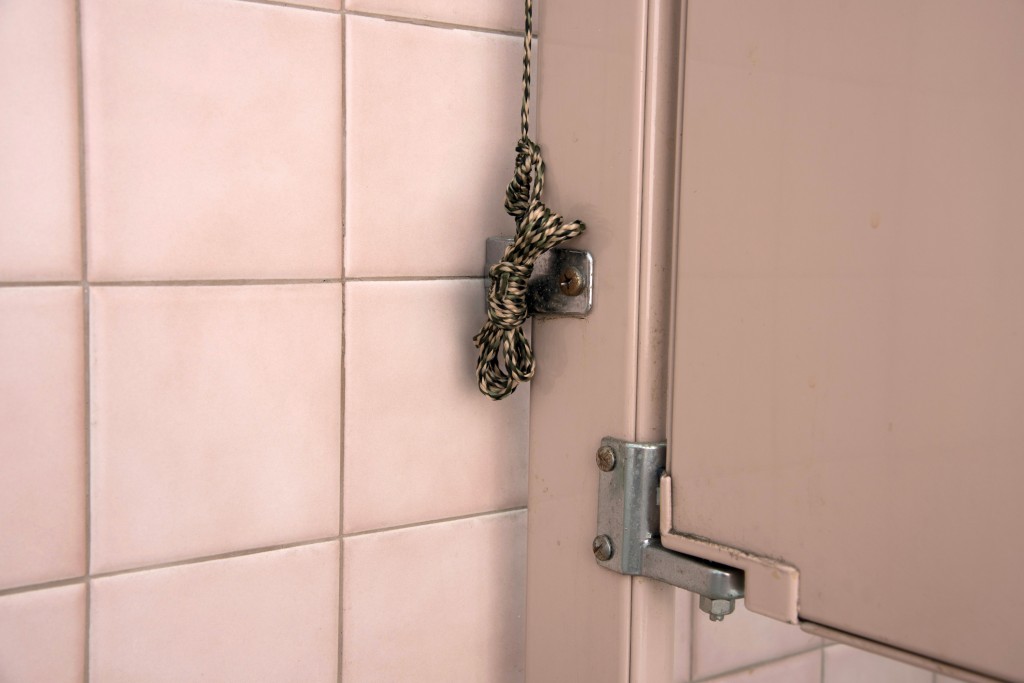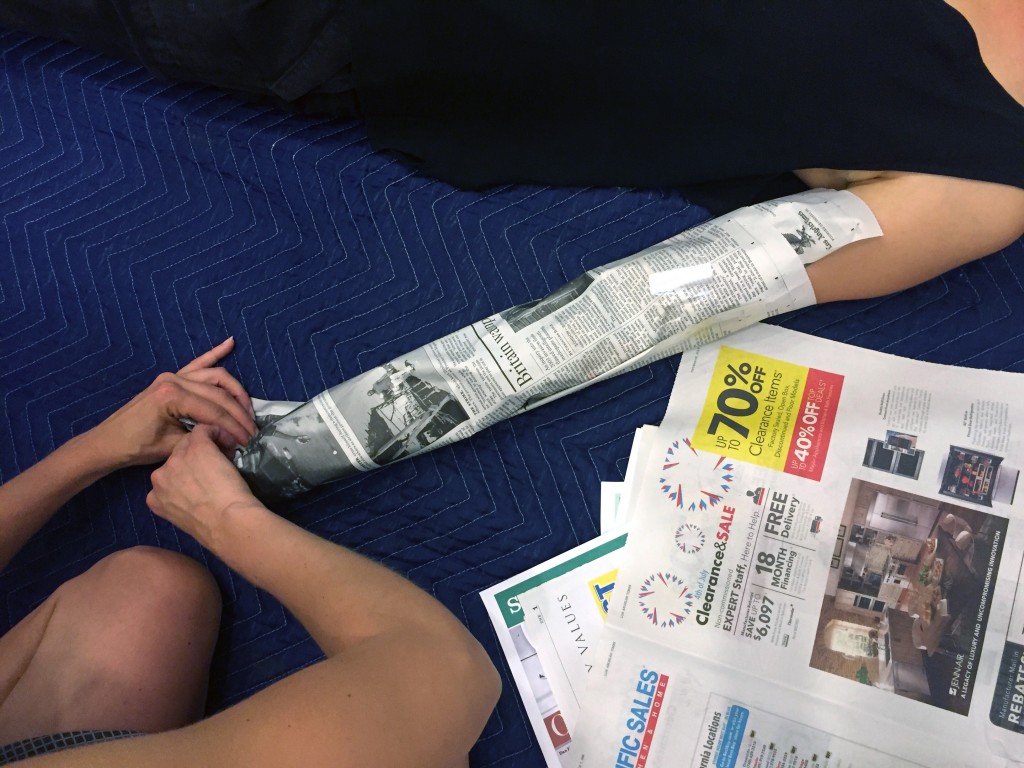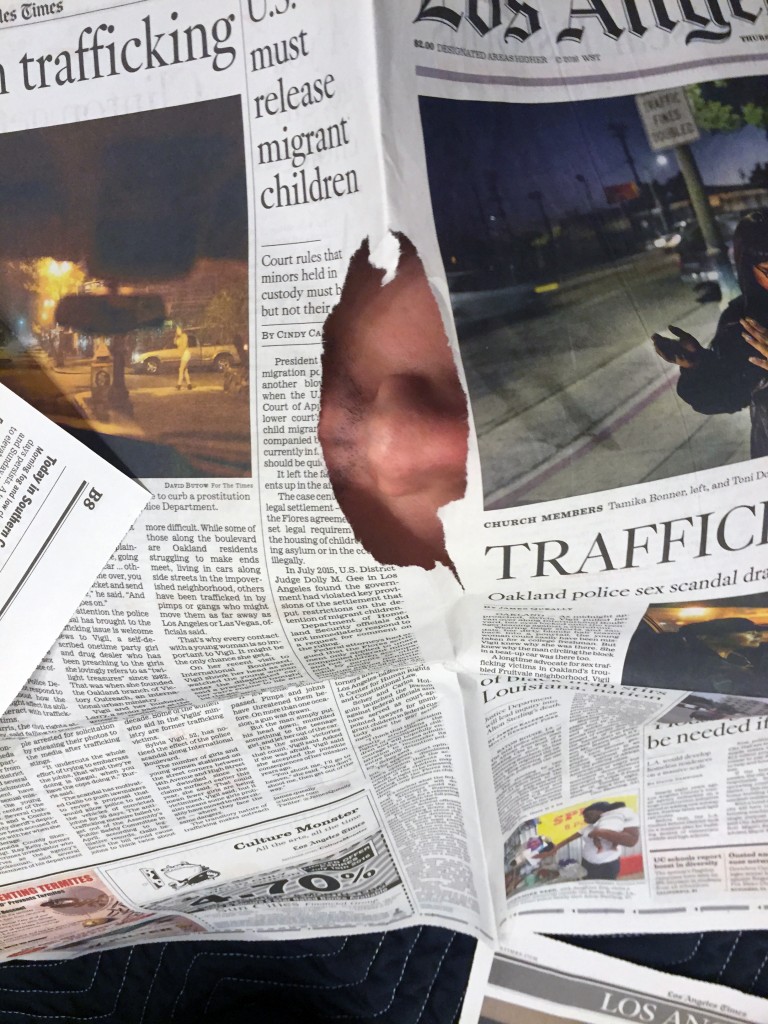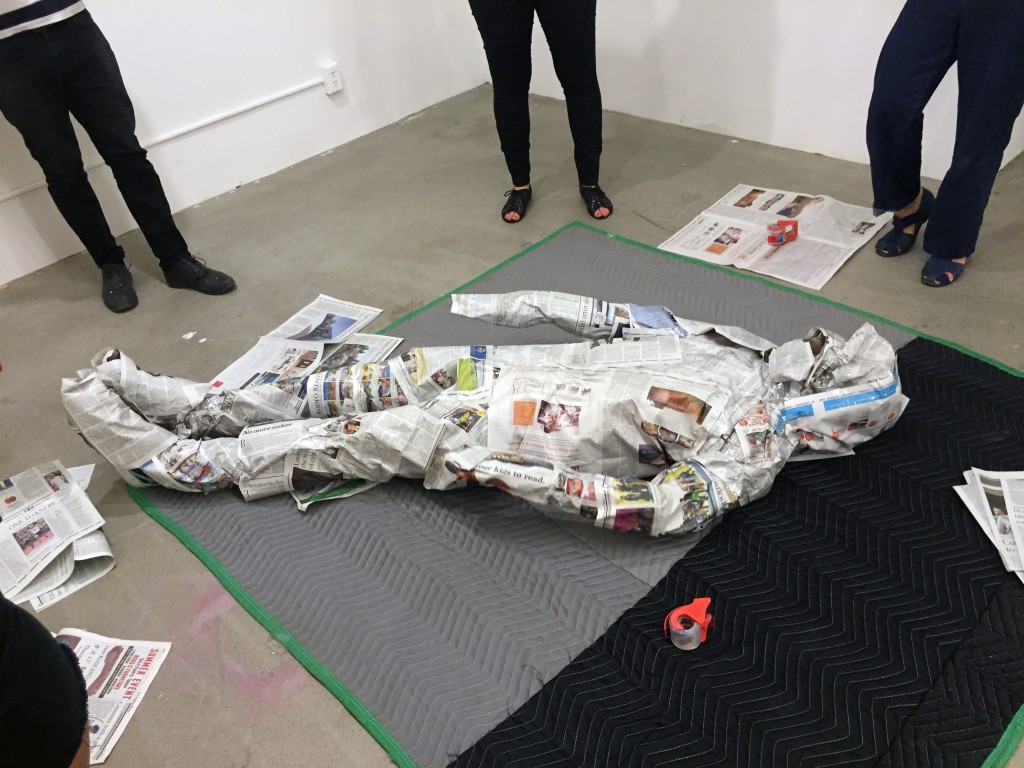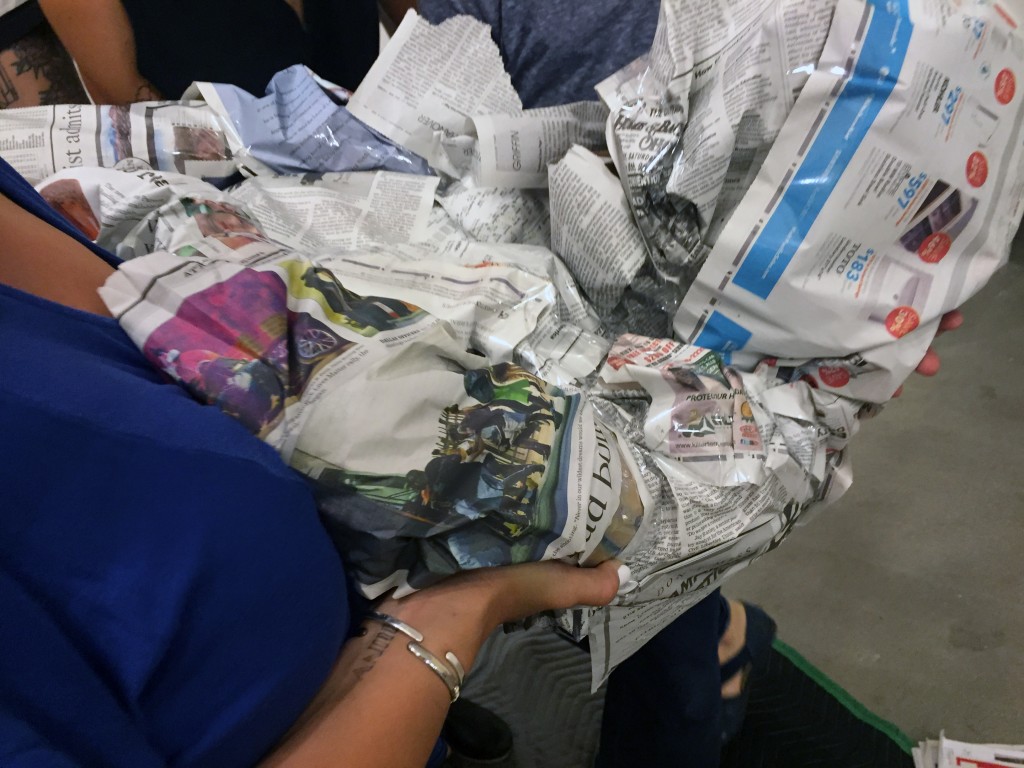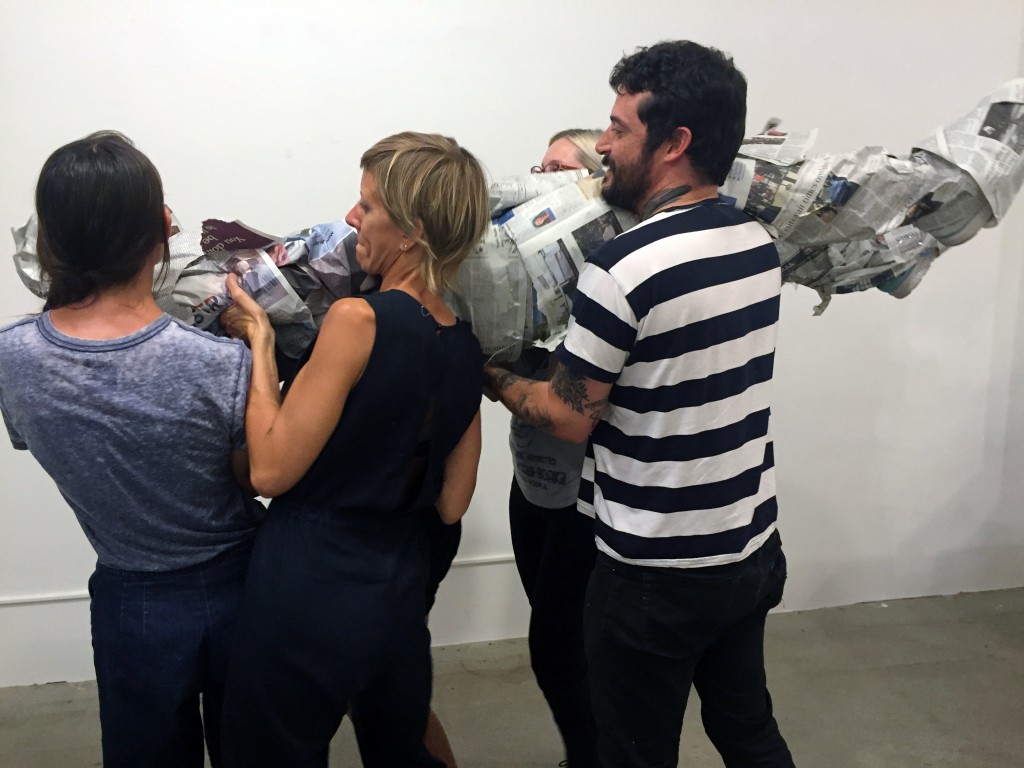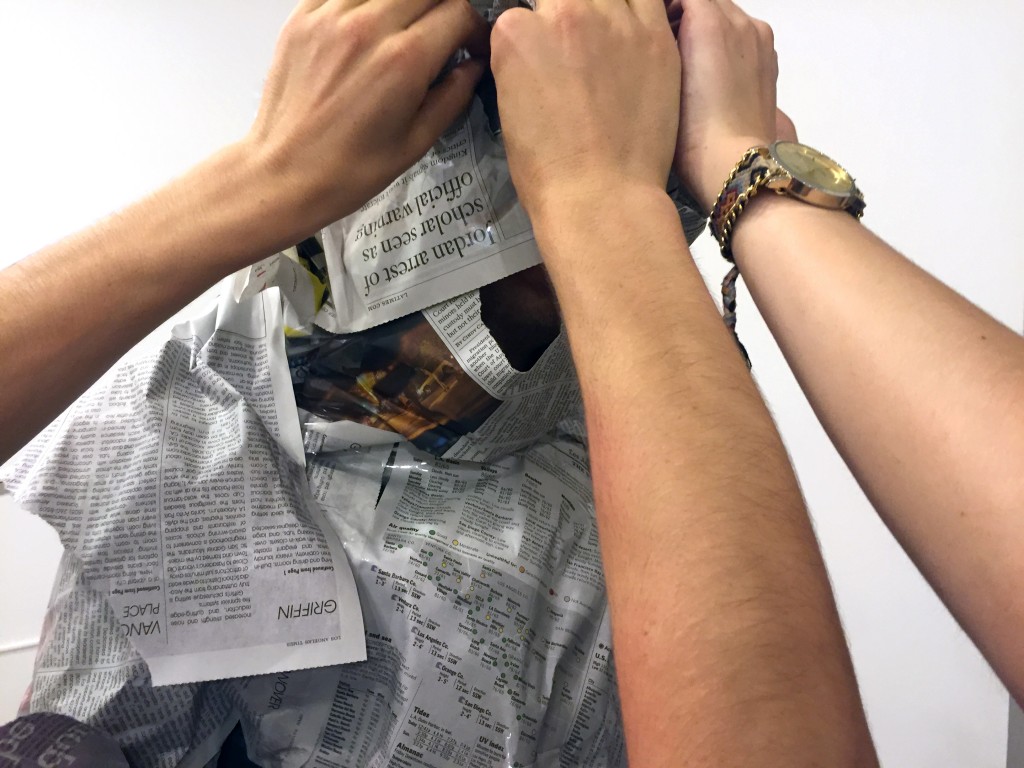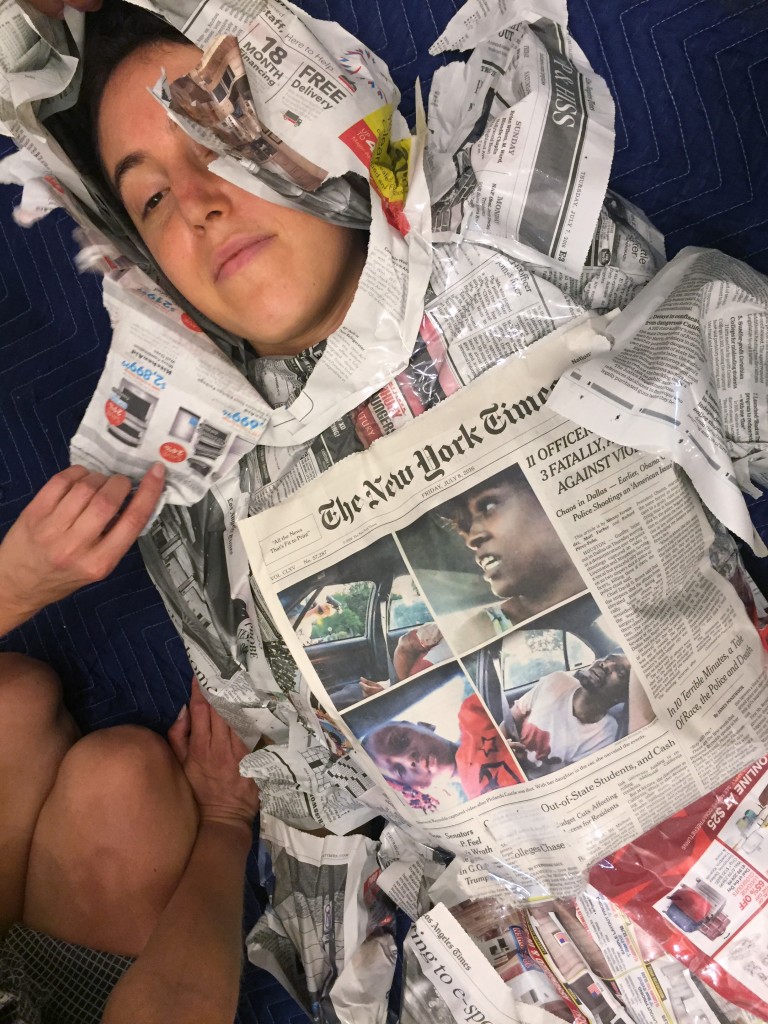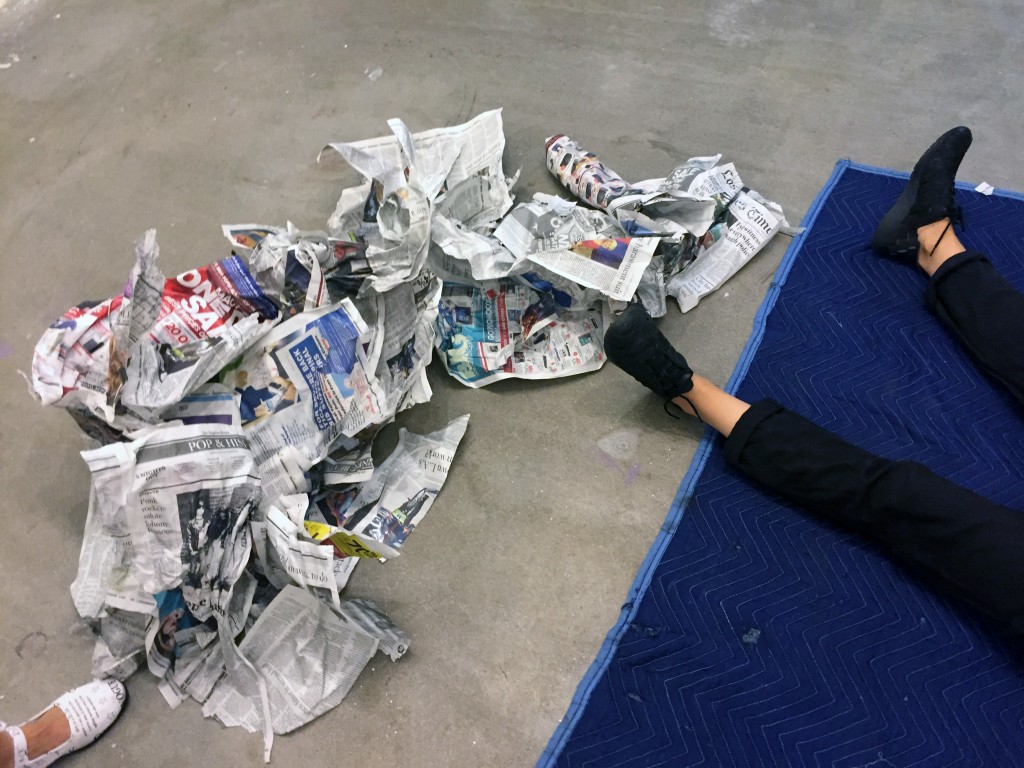Full Body
Full Body is an exhibition that takes place in the recently converted all-gender restroom on the 11th floor of The Reef building, in support of the building re-designating this space and as an alternative to white walls. With a total of seven works, each work is displayed individually over a four month period. The exhibition explores the sensory, social, political, and economic aspects of the body in the context of HB2, the shootings of Alton Sterling and Philando Castile, the European refugee crises, and the 2016 U.S. presidential race. Artists include: Lygia Clark, Alyse Emdur, Paul Mpagi Sepuya, Julia Kouneski, Jules Gimbrone, Dan Bustillo, and Barbara T. Smith. The term “full body” is one that comes from the massage and bodywork world. It is a term that a client may use should they want the therapist to address the “whole” of their body. The term is democratic and expansive and the concept of entirety and what delineates a body is the subject being explored in the exhibition.
“Full body” is a term housed in the field of care work. It acknowledges the wholeness of all bodies with care.
—
WORKS
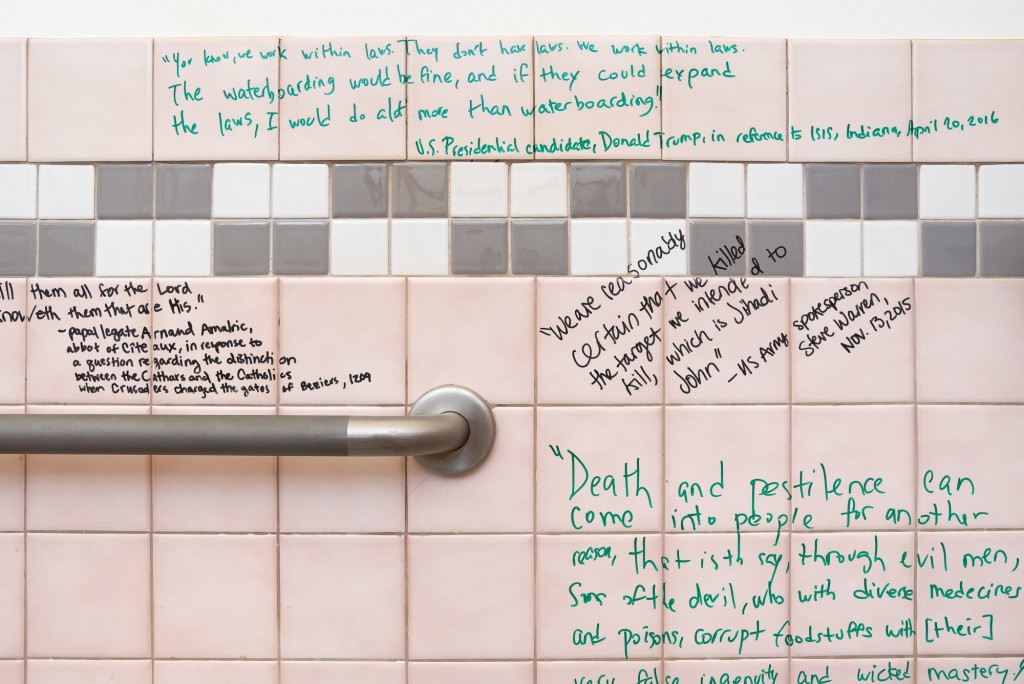

Opening reception Sunday, October 9th 2-4pm
October 9th- October 16th
To the master bedroom where the vampires feast
The ghouls all came from their humble abodes
To get a jolt from my electrodes
-The Monster Mash by Bobby “Boris” PickettFull Body presents WHERE IS THE CLOSEST CITY WELL?, a new installation by artist and writer Dan Bustillo. For the work, Bustillo takes quotes from medieval religious leaders and contemporary U.S. politicians, and scribes them to the walls of a stall in the all gender restroom, paralleling the witch hunts of the past with the treatment of bodies deemed “threatening,” today. The title alludes to the medieval fear of contamination, when the poisoning of a town well was of serious concern since it could wipe out an entire community. The installation is a physical manifestation of Bustillo’s 2-year long research on surveillance studies, Western medieval persecution ideologies, and intersectional theory. Of their research, Bustillo writes:
Lately, I have been imagining myself as a medieval sodomite. I have been thinking about the threat that the heretic was perceived to have posed to the health of the white catholic body in the Middle Ages, in parallel to the one that is presented as a corruption of Western democratic values by what Jasbir K. Puar calls the “terrorist monster fag.” For Puar, the post-9/11 “terrorist” fag is a non-white, non-national, crafted out of an exchange she has dubbed “homonationalism”– a process that renders LGBTQIA agendas “fit for capital” at the direct cost of a “racial other,” and ironically perpetuates a racist and homophobic paradigm.1
The paradox of the modern Western mission in the War on Terror lies in its attempt to fuse Western democracy with universal values as a justification for the wiping of all grounds where evil may fester. In the Western Middle Ages, witches, Jews, Muslims, heretics, sodomites, and lepers, were routinely persecuted out of fear that they might contaminate the pious, straight, cis, healthy Catholic body of the West. What, then, might constitute a corporal threat in a post 9/11 scopic regime that genders, racializes, sexes, and faiths bodies differentially, assigning a penal clout to each body it categorizes?
Out of the Old French monstre, mostre and the Latin monstrum “divine omen, portent, sign; abnormal shape; monster, monstrosity,” the term “monster” emerges in the early 14th century in reference to a “malformed animal or human, creature afflicted with a birth defect.” Tethered to its etymological root is its ability to demonstrate; the Latin monstrare means “to show.” One interesting yet unintended consequence of characterizing a monster as such is to point to the often toxic and seemingly arbitrary rules we have internalized. According to Jeffrey Jerome Cohen, monsters operate at the level of discourse, dwelling in “the shared imaginary of the normal dominant culture,” as border phenomena, and “by inhabiting the gap between exclusive zones of intellectual or social meaning, deliver a threat to the zones’ integrity, to the assumption that such zones can be delimited in the first place.”2
1. Jasbir K. Puar, Terrorist Assemblages Homonationalism in Queer Times, (Durham: Duke University Press, 2007), 46.
2. Cohen, Jeffrey Jerome, Monster Theory, (Minneapolis: University of Minnesota Press 1996), 266.
—
Jules Gimbrone: Monomorphic Surfaces (or what I listen for when I listen in Men’s bathrooms)
Opening reception Saturday, September 24th 2-4pm
September 24th- October 1st
Salt water
Cooking oil
A desiccated banana
A balloon
Water beads
Two brass bells
Recording of piss going into a potThis vessel is accompanied by another that has been broken.
Jules Gimbrone is an artist and composer that asks how social performance is codified, captured, and transmitted. Using a variety of recording and amplifying technologies—in addition to materials such as clay, ice, and the ambient sound of past performances—Gimbrone investigates how sound travels through space, bodies, and language as a way of exploring hidden or sublimated gendered systems.
For Monomorphic Surfaces (or what I listen for when I listen in Men’s bathrooms), the artist considers the differences between male and female anatomy. As a transgender or non binary person, Gimbrone cites the bathroom as a particular space where thoughts and projections regarding these differences, specifically the difference of genitalia, become emphasized in a way that is not felt elsewhere. The concept of biopolitics articulates that these differences, and the materiality of sex in general, are constructs of political and social power structures that attempt to enforce authority over bodies by constricting them to assigned categories, such as gender and sex.
Gimbrone’s vessels exist beyond the confines of their glass walls and continue in the form of their audio hitting our ears and tissues; their conceptual, political, visual, and auditory interpretations; and an infinite number of manifestations, as is the case with all bodies. Constructing a piece that purposefully transcends its materiality while also utilizing the sound of urination, one that is homogenous between both gendered restrooms, Gimbrone has created a body that gently eliminates corporeal boundary lines.
Gimbrone received a BA from Smith College in 2004 an MFA in Music Composition from California Institute of the Arts in 2014. Gimbrone has been exhibited at venues including Human Resources, Los Angeles; Vox Populi, Philadelphia; FLAX Fahrenheit, Los Angeles; Cuchifritos Gallery, New York; MoMA PS1, New York, and Park View Gallery, Los Angeles. Gimbrone is the Artistic Director and Co-founder of PSSST, a non-profit art space in Los Angeles.
—

Julia Kouneski: Shared Breath
Opening reception Sunday, September 4th 2-4pm
September 4th- September 14th
The 11th floor of The Reef building is occupied by internet based companies like Postmates, Peerspace, HopSkipDrive, and General Assembly. The floor is a site of virtual labor, in which work takes place mostly in front of a computer screen. The widespread social epidemic of anxiety and panic are considered symptoms of the disembodied and isolated state this mode of labor can create, posing the question of whether anxiety and the shortness of breath that accompanies it, is our current collective pathology.
The breath, a life force that animates our bodies, oscillates between its interior and exterior spaces, tracing both public and private, intimacy and shared space, the individual and the political. For the fourth iteration of the Full Body exhibition, Julia Kouneski will present her “Shared Breath” objects in the all gender restroom on the 11th floor of The Reef building. These objects hold the possibility for an intimate, corporeal exchange with another person and will be available for visitors to take and use at their discretion throughout the week.
Julia Kouneski is a Los Angeles-based artist working primarily in performance and video. Her work investigates embodiment and negotiates the boundaries of the sensing, sensitive, and sensual body. Her recent work has been shown at metro pcs in Los Angeles and at FD13 Residency for the Arts in St.Paul. She received her MFA from the USC Roski School of Fine Art in 2014.
Paul Mpagi Sepuya: Studio Objects
One Night Only: Friday, August 12th 8-10pm
Paul Mpagi Sepuya’s practice speaks through the subjects of figures and grounds. He writes, “My subjects are those people who move within overlapping circles of personal, creative, and erotic exchange and collaboration. The photographs staged or sourced from these relationships generate works that explore the complication and gratification that production, reception and response to portraiture means in an expanded definition of the genre.” Sepuya uses a variety of grounds on which to present the subjects in his photos: his studio walls, old photographs, black muslin, draped fabrics, and mirrors. Sometimes it becomes unclear where one begins and another ends, confusing time and space, creating a plane where the delineation and separation between events collapse into the every and the infinite, heightening the subjects in his work and perhaps allowing them to exist beyond the confines of their own flesh and body.
In collaboration with Full Body, an installation of objects from Sepuya’s studio will be presented in the all gender restroom at The Reef. These objects each consist of a portrait that has been fragmented then adhered to mirror, moving the determined image of a photograph and its subject into something fluid in both representation and space. Intended to be used as a ground from which to photograph, these works were created for his Figure Studies project and in themselves are considered intermediary objects that avoid resoluteness. In collaboration with Full Body, the mirrors which usually reflect Sepuya, his camera, and the space of his studio instead lend their reflections to expand upon the architecture of the all gender restroom and multiply the image of its occupants.
Paul Mpagi Sepuya (1982, San Bernardino, CA) lives and works in Los Angeles, where he received an MFA in photography at UCLA. He resided in New York from 2000-2014, where he participated in Artist-in-Residence programs at the Lower Manhattan Cultural Council, the Center for Photography at Woodstock, The Studio Museum in Harlem and Fire Island Artist Residency. Sepuya’s photographs are in the collection of the Guggenheim, the Studio Museum in Harlem, Center for Photography at Woodstock, and zines can be found in MoMA Library, Brooklyn Museum Library, and Fotomuseum Winterthur. His work was recently featured in storefront: PUBLIC FICTION at The Museum of Contemporary Art Los Angeles.
Opening reception Sunday, July 24, 2016 at 4pm-6pm
July 24th-July 31st
LadyCom is a lifestyle magazine for military wives that was published in the U.S. in the 1960’s, 70’s and 80’s. With headlines like: How to Survive by Mail, The Military Wife and Alcoholism, and Making it in a Man’s Military, the magazine gives a historical look into the gendered space of the military and military wife. Chock full of advertisements for soap and grocery store sweepstakes, LadyCom paints a picture of the military wife obsessed with cleanliness, looking her best, and penny pinching with the will to survive a distanced relationship. It also frames the female body and its proximity to war at that time; while men were out witnessing death and dying, LadyCom encourages women to experiment with cornbread recipes.
As part of the Full Body series, Alyse Emdur is installing her collection of LadyCom magazines in the all gender bathroom on the 11th floor of The Reef for its tenants to browse this week. Considering the public restroom as a semi-private, interstitial space available to make a phone call, look in the mirror, check hair, refresh lipstick, have a quickie, wait for the next stall to open up, or for the boss to leave the office, the magazine collection offers material to occupy this space of waiting while also pointing to the military wife in waiting.
The exhibition provides an alternative context for considering American military policy; how it has historically enforced gender roles, and how those roles are being changed by recent legislation. The exhibition also serves as a space to consider the wider national history of segregational policies impacting the usage of public restrooms, beginning with Jim Crow and extending to the passage of contemporary bathroom bills.
—
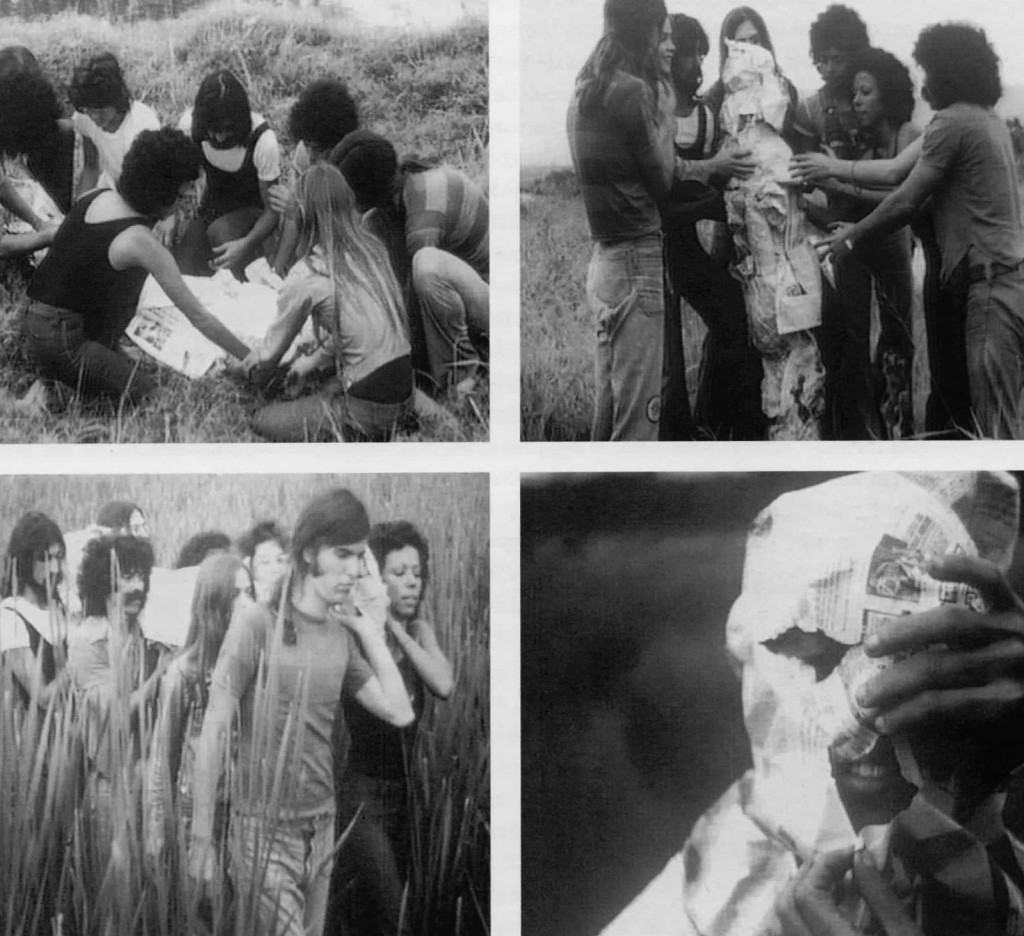 Lygia Clark, Viagem (Voyage), 1973
Lygia Clark, Viagem (Voyage), 1973
Julia Kouneski will facilitate a collective re-creation of Lygia Clark’s Viagem (1973)
Saturday, July 9, 2016 at 2pm
Space is limited, please RSVP tatianavahan@gmail.com
Brazilian artist Lygia Clark (1920 – 1988) was a founding member of the Neo-Concrete movement, which thought of an artwork not as an object but as a “quasi-corpus” (an “almost-body”), which could only be understood through a direct, phenomenological approach. Over the course of her career, beginning as a painter and ending as a practitioner of her own form of body/object therapy, her work became increasingly difficult to categorize, expanding societal delineations of both art and healing.
Viagem is one of the collective experiences Clark visioned and created with her students at the Sorbonne in France, while in exile from the dictatorship in Brazil. Pre-dating her one-on-one sessions in which she created her own form of body/object therapy, these group experiences were an earlier form of “collective therapy,” which she called Corpo Coletiva (Collective Body). In these pieces, the group mobilized around one person to facilitate an embodied and often transformative experience. For Viagem, which translates to voyage in english, the audience participates in shrouding a volunteer’s body with newspaper. Once covered, the volunteer’s body is lifted and carried off on a journey. Eventually the body is laid down and unwrapped.
Julia Kouneski is a Los Angeles-based artist working in performance, video, and participatory projects. In an exploration of the sensory body central to her work, she has studied many forms of somatic movement practices and bodywork. In 2009 she received a grant to travel to Rio de Janeiro where she spent 2 months researching and experiencing the work of Lygia Clark. Since then, she has led educational re-creations of Clark’s work for small groups. She received her MFA from the USC Roski School of Fine Art in 2014.
/// Post-Viagem Discussion: July 9, 2016
Jesse: When I was being wrapped in the newspaper, I had the feeling of being a baby, and being tenderly dressed. And it also felt really tender and nice to be carried around. And then it felt like being a snake shedding a skin or something at the end, and that felt really good too…
LeRoy: I’d say I had a similar feeling… and at one point when my hands were covered, they became these kind of strange appendages, and my body felt strange and a little different. And it was actually a really nice feeling with everybody encasing me… being encased. I didn’t think too much at the time about the context of the news, maybe just a little bit at the beginning when I looked at the front page of today’s edition. And at one point I was thinking, am I way too heavy?
Julia: It was heavy (!).
LeRoy: And maybe a similar feeling of shedding a skin, your skin, or maybe your thoughts as a kind of enclosure. It was satisfying in a way to take that all off. It was really hot I’d say, inside, so it felt kind of good too.
Julia: I was carrying LeRoy, in LeRoy’s group, and he was really heavy which I didn’t expect, maybe for all of us… but it’s also interesting just how heavy a body is, to carry a body, that it takes that many people.
Nick: It was interesting as we wrapped him up more and more, he was less LeRoy and more like an object. …. (missing some talking here) … And it was really nice to take it off of you and be aware that it was a person.
We had a little bit of a ——- when we were carrying her…. and Tatiana moved a couple times to get in different positions, and at one point she just left the head, and it just …. It was definitely like the burden of carrying this thing that lost it’s sense of humanness.
Jesse: It was interesting too because I was wondering, should I be tending to everyone else or should I try to keep my head up, and I was like, No, I think I’ll probably let go and see what happens.
Julia: Yeah, and getting through the door, it was like “Watch the body, watch the body!”
LeRoy: ———-
Agnes: I’m curious, I don’t think anyone else was in the building as we were passing through, but it would be really interesting if someone in an office could see…
Tatiana: I felt a responsibility to document, which is such a thing of our times… it reminded me of a performance that Nick and I went to in the Angeles National Forest where we were surrounded by nature and this beautiful performance was happening put on by LAND, and I was so annoyed that they had this huge camera documenting everything so it kind of pulled you out of the present thing happening. As someone who was documenting I really wanted to be more participatory in this performance, but then thinking about the content about what’s in the papers [Alton Sterling, Philando Castile, and Dallas Police shootings], and this woman [Diamond Reynolds] who livestreamed her boyfriend dying, essentially. It was interesting to think about the two sides of that while I was documenting. Like the dispersion of information, and how sometimes it’s really important because it can bring people to the present situation, like I think it brought a lot of people’s presence to that event. It brought people there and affected them. And then the other side of it is that sometimes you’re not present for that actual thing because you’re thinking about the other side of it. So the two sides to that. I was also thinking of the body and the sensory, and thinking of these news stories and presence, and how we were tuned in to the weight of a body, the reality of these events and the bodies in them. This whole series is thinking politically about bodies, and in this case black bodies, and in other news refugees, and trans-bodies, and different kinds of bodies. I was thinking about carrying those bodies and the weight of those bodies.
Jesse: It’s interesting to me that maybe it’s a culturally specific thing, that it’s kind of important to feel the weight of a body, for most of us, or all of us.
Nick: Yeah when we were carrying you it felt like pallbearers at a funeral or something.
LeRoy: Yeah I was feeling this is what it would be to be dead, but with consciousness. And like an old-fashioned burial.
Tatiana: It’s interesting in death, our bodies are carried, and I was also thinking birth. My mom’s a midwife so maybe naturally that’s what I think of, hands holding and delivering a body, which obviously is a very different kind of body, a much smaller body.
Nick: Carried in and carried out.
Jessica: But we’re usually carried out in something, and I was very aware of the weight but also how difficult it is to carry someone who’s not contained within something.
Julia: Yeah, and this whole covering and uncovering thing, something that I’ve thought about with her work that’s interesting to me, and hearing you say when you’re uncovered what that feels like– It’s interesting to me that sometimes it’s like that covering needs to happen before you can feel the opening…
LeRoy: Also it was like something that kids might do, but maybe adults don’t do something like this that often. It’s an experience that you don’t always give yourself.
Tatiana: That makes me think about what would this look like if kids did this, there’s this kind of comical aspect of covering ourselves with something… I wonder if it would be more funny if kids did this.
Agnes: I think kids can actually be pretty dark, and might actually be little more brutal with the body.
Freddie: ——–
LeRoy: Julia, when Lygia Clark would do these pieces, would there be a number of these pieces in a day, or would they be these kind of workshops where they were all familiar with each other…
Julia: From what I know, it was the same group of people. It was a class, her students. I don’t think they would do more than one per day, but throughout the class they would do these different pieces, but together with the same people. And what started to happen there, is that people started to have really interesting experiences that came out of it, that might happen if you’re with the same group of people doing this over and over. Memories they would have, or images they would see related to their history perhaps, so it became more psychological in relation to the body, which I think is really fascinating… I think that takes more time, and more trust with people… So this is a taste today.
Tatiana: It also totally changes depending on what news events are happening.
Julia: It’s interesting because she [Lygia Clark] doesn’t talk too much about that aspect, and I kind of get the picture that she was using the newspaper just as a material that was easy to find. A lot of her work was everyday materials that she found and put together. So maybe the content of the news is more related to doing this in our context today.
Jesse: It was strange because since we talked about it [the news] before doing it, I was thinking it was going to be so heavy to do knowing what is on these newspapers wrapping me up, but what happened was that I started to smell the newspaper as I was being wrapped up, and I just got this nostalgia for being a kid and my parents opening a newspaper, and blueberry muffins and coffee. And I was like, but what about?… and it just wasn’t viscerally there.
LeRoy: The crinkling by my ears was kind of nice, and it was also a snowsuit kind of feeling, like being really warm in a snowsuit …
Agnes: Have you done any other Lygia Clark re-creations?
Julia: The one that I was talking about, Baba Antropofagia, and in a class we made some of her Relational Objects with students and did some group experiences with those objects. And this one, I had only done once before for a very short time, so this was kind of new for me too.
Tatiana: Thanks for coming everyone.
—
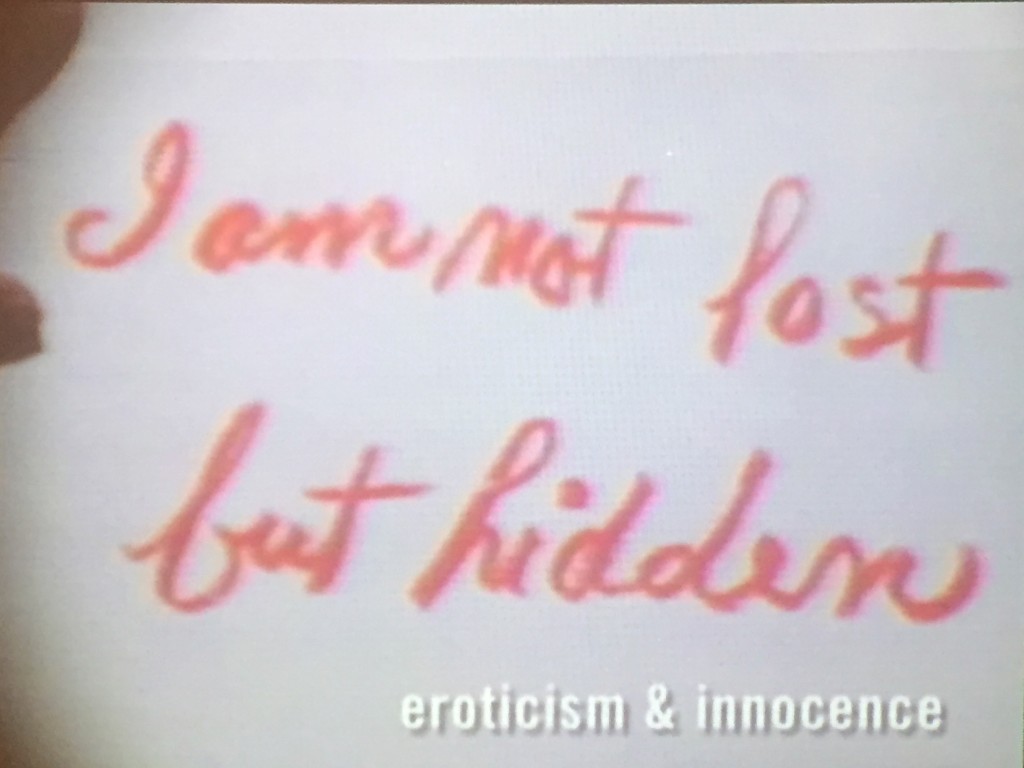
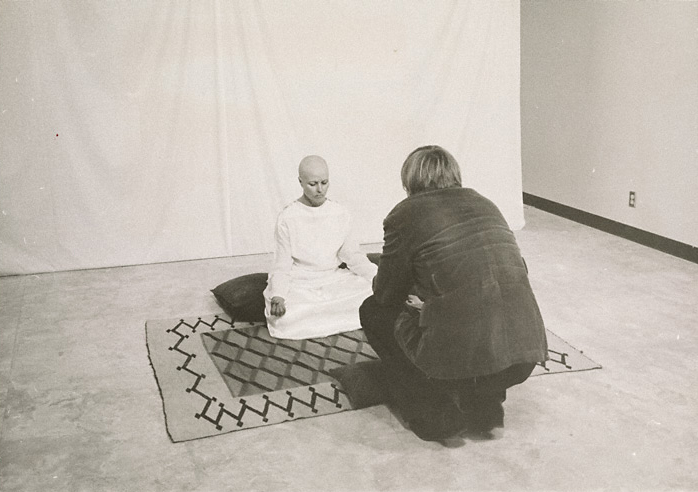 Full Jar, Empty Jar performance at Art Gallery, University of California, San Diego, 1974, Barbara T. Smith. © Barbara T. Smith
Full Jar, Empty Jar performance at Art Gallery, University of California, San Diego, 1974, Barbara T. Smith. © Barbara T. Smith
Barbara T. Smith: The Inner Landscape
Screening Thursday, November 3rd 6-8pm
Screening starts at 7pm
Barbara T. Smith is one of the pioneers of Performance Art beginning her groundbreaking work in the late 60’s. She has performed throughout the U.S., in Europe, and in Asia. Trained as a visual artist, Smith began her body-oriented work in 1965. By ’68 she was creating powerful transformational performances and has continued to the present. The work often externalizes her inner psychic material in psychic rituals, based on issues of gender, spirituality, and sexuality and are integrated with larger cosmic laws and structures. Many pieces are intimate, personal, and participatory often extending over many days, using her own body as a vehicle and vortex to develop an expansion of consciousness.
In The Inner Landscape, Smith has compiled documentation from 27 of her performances spanning from 1969 to 2001, and accompanied these vignette’s with her own voice over narration. The compilation gives the audience an opportunity to explore her work over many years witnessing her artistic and personal growth. Collectively, The Inner Landscape demonstrates Smith’s pursuit of performance art as a method of healing and spiritual connection.
This screening takes place in suite 1150 and is the final work presented in the Full Body exhibition.
—
